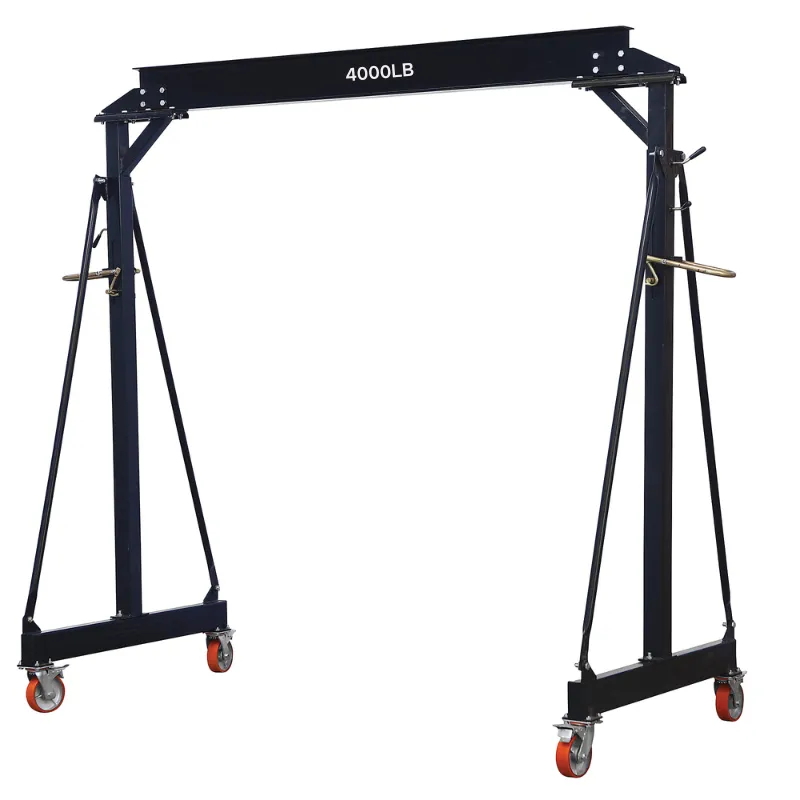Types and Applications of Gantry Cranes in Various Industries
Types of Gantry Cranes An In-Depth Look
Gantry cranes are vital pieces of equipment in various industries, used primarily for lifting and moving heavy loads. Their design, characterized by a frame that straddles the area where work is being performed, provides stability and flexibility, making them essential in settings ranging from shipyards and warehouses to construction sites. This article will explore the various types of gantry cranes, their unique features, and their applications across different sectors.
1. Fixed Gantry Crane
The fixed gantry crane is one of the most common types. As the name suggests, this crane has a stable, non-moving structure that supports its lifting mechanism. Fixed gantry cranes are typically used in environments where the operational area is static, such as in manufacturing plants or warehouses. They can be equipped with a variety of lifting devices, such as hoists or winches, to facilitate operations. Their design allows for heavy loads to be lifted vertically and then moved horizontally along the beams. While they are extremely efficient for heavy lifting, their lack of mobility means they are best suited for dedicated applications.
Adjustable gantry cranes offer greater versatility than fixed cranes. As their name implies, these cranes feature adjustable legs, allowing the user to alter the crane’s height and span. This adaptability makes them suitable for a variety of tasks, including loading and unloading materials in various settings. They are often employed in workshops and construction sites where different heights and widths are required for different projects. Though not as stable as fixed gantry cranes when extended, they compensate with their flexibility, making them a popular choice for contractors seeking a multifunctional lifting solution.
3. Portable Gantry Crane
types of gantry cranes

Portable gantry cranes are designed for easy transport and assembly, making them an ideal choice for companies needing lifting solutions in multiple locations. These lightweight structures can be moved from one job site to another and are quick to set up, requiring minimal tools. Their portability makes them popular for smaller operations, including home garages, workshops, and manufacturing lines. Despite their size and lightweight design, portable gantry cranes can lift considerable loads, typically ranging from 1 to 10 tons, depending on the model. They are often constructed from aluminum or steel, providing a balance between strength and weight.
4. Cantilever Gantry Crane
The cantilever gantry crane features a design that extends one side of the crane beyond the support leg. This design allows for greater working space underneath the structure, making it easier to load or unload from one side without interference from the support legs. Cantilever gantry cranes are particularly useful in shipyards, where they are used for loading and unloading ships efficiently. Their design not only maximizes workspace but also enhances safety by reducing the risk of accidents related to obstructions.
5. Full Gantry Crane
Full gantry cranes are larger structures that often span significant distances and are ideal for heavy-duty applications. They are typically seen in industrial settings such as loading docks, ports, and large warehouse operations. These cranes can be equipped with multiple hoists or lifting devices, allowing them to tackle various tasks simultaneously. Full gantry cranes can move along runways, providing an extensive reach and mobility to handle massive loads. Their robust design and engineering make them essential for operations that require consistent and reliable heavy lifting.
Conclusion
Gantry cranes play a crucial role in the efficiency of lifting and moving heavy materials across numerous industries. With various types available, from fixed and adjustable to portable and full gantry cranes, each type offers unique features suited for specific tasks and environments. Understanding the differences between these cranes allows businesses to choose the best equipment for their needs, ensuring maximum productivity and safety. As industries continue to evolve, the demand for specialized gantry crane solutions will likely increase, driving innovation within the field and enhancing the capabilities of these essential machines.
-
Unlock Seamless Relocation with Our Heavy Equipment Moving ExpertiseNewsJun.06,2025
-
Unleash Unrivaled Flexibility with Our Adjustable Gantry CraneNewsJun.06,2025
-
Unleash Heavy-Duty Efficiency with Our Industrial Gantry Crane SolutionsNewsJun.06,2025
-
Revolutionize Steel Handling with Our Magnetic Lifter RangeNewsJun.06,2025
-
Master Equipment Mobility with Premium Machinery Mover SolutionsNewsJun.06,2025
-
Elevate Your Material Handling with Magnetic Lifter TechnologyNewsJun.06,2025
-
YS Permanent Lifting Magnets: The Smarter Way to Handle SteelNewsMay.22,2025
